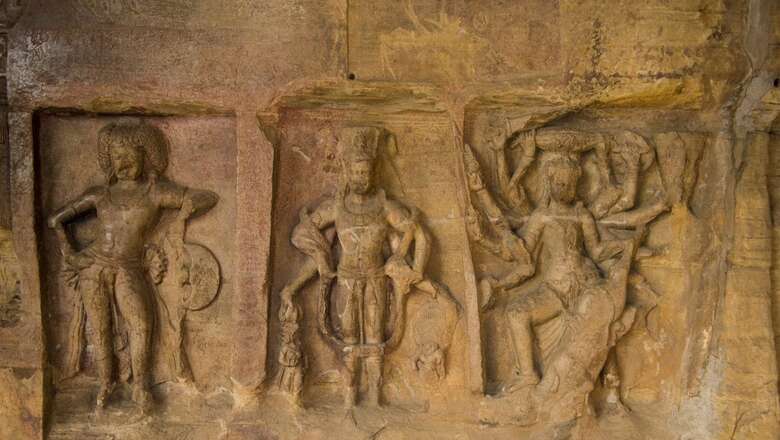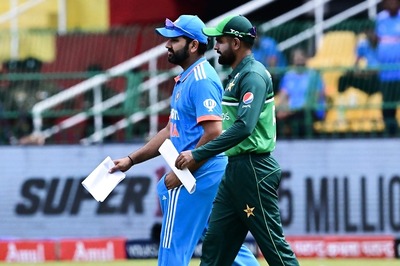
views
Recently I came across an article — ‘Gupta Period wasn’t exactly the glorious Hindu age that we are told. It’s complicated’ — written by Sahitya Akademi Yuva Puraskar winner Anirudh Kanisetti. The impact and influence that India’s first Yuva Puraskar winner, Vikram Sampath, always made me look upon such winners in high esteem. Unfortunately, as I began to read Anirudh’s works, I could only question the veracity of the award in current times.
Anyway, let’s cut the rhetoric and dissect his article on the Guptas.
He begins by writing, “The term ‘Bharat’ in today’s imagination conjures up a return to a pure, primarily ‘Hindu’ golden age — an image carefully curated by colonial historians and accepted rather unquestioningly today.”
This statement speaks of all but honesty. The truth of the matter is that Bharat is not about a return to the push towards the Hindu golden age, rather it is a push towards recognising ourselves from our perspective. Historically, Bharat was always seen as the name of our land right from the Rig Vedic Period. Bharati was a devi in Vedas and even Mata Saraswati was recognised as Bharati at times. Our kings too take the title of Bharat, as it, at times, also represented the Chakravartin of a given period. Well, there is no denial of the fact that the term ‘India’ comes from Sindhu which became Indu in the eyes of the Greeks and hence we got the works like Indika. But this too represents a Western perspective which had an Indian origin. The Vishnu Purana, which defines Bharat, ranges between the Himalayas and the ocean. So even though it has nothing to do with any golden age, the term ‘Bharat’ has certainly everything to do with recognition of who we are from our own lens.
He writes, mentioning the paper, ‘The Seated Lady and the Gupta King’ by art historian Ellen M Raven, building a case about the Gupta appropriation of a popular Kushan coin design:
“A standing emperor wearing mail coat and trousers, sacrificing at an altar and holding a sceptre, with a seated goddess on the reverse. This goddess, the Zoroastrian deity Ardokhsho, holds a cloth diadem in one hand and a cornucopia (a tapered basket full of vegetables and fruit, a Hellenic symbol of abundance). Neither the emperor’s costume nor the goddess’ attributes can be considered ‘Indic’ — and yet they appear profusely in Gupta coinage. Ardokhsho was quite seamlessly understood to be Lakshmi, the goddess of royal fortune to the Guptas (…)”
Well, this article is not intended to critique the paper of Raven, but to sum up, she has got everything wrong about the coin. The assumption Anirudh has is based on Raven’s paper whose notion is based on the conception that Vedic gods were appropriated from the Zoroastrian systems. For them, it is most likely that the similarity between Avesta and Vedas is a reason to believe in ‘Aryan Migration.’ But the truth stands otherwise. Shrikant G Talegeri systematically explained in his books that the later books of Rig Veda and Avesta developed in the same period, which happens to be the post-migration of certain tribes westwards, also included the tribes that would be known as Iranians in the later phase.
It means that all the notions of gods and goddesses arising in Iran and Bharat were happening simultaneously with the common influence of early and middle books of Rig Veda. Hence, it is highly unscholarly to believe that the Guptas copied a Zoroastrian goddess or former copied it from Hindus.
We do find mention of Lakshmi in Rig Veda (X.71.2) as below:
भद्रैषां लक्ष्मीर्निहिताधि वाचि
bhadraiṣāṁ lakṣmīrnihitādhi vāci
“an auspicious fortune is attached to their words.”
Here the term “Lakshmi” refers to “kindred mark, a sign of auspicious fortune.”
Interestingly, Ardoksho (in Greek, which Raven speaks about to be present in the Gupta coin), is the Iranian goddess of wealth and was known in the Avesta as Ashi. Before we investigate the presence of “Lakshmi” in Bharatiya texts, let us dwell deeper into the Ashi.
Avestan Ashi is already attested seventeen times in the Gathas, the oldest texts of the Zoroastrianism which appeared in the same period as the last books of Rig Veda. But here it is more an abstract concept, which would get all the details as the divine one in younger Avesta. It occurs thrice in Gatha with the adjective “good” (vanuhi).
In the Gathas, Ashi is often identified with asha “truth”. Let’s pick Yasna 51.10 as an example where the poet calls as below:
“For my own people Asha I invoke,
And pray for blessings from Thy Love and Truth.”
Does it not sound like Rig Veda (X.71.2) as quoted above? But here blessings are expected in the afterlife. We observe a similar notion in Yasna 43.5 where Ahura Mazda assigns “reward for deed and word: evil for the bad, good blessings for the good.” Then in Yasna 50.9, given the proper conduct in life, Ashi is connected with Zoroaster’s concept of free will, where a mortal has the power to influence his own reward.
As we move into younger Avesta, Ashi’s divinity becomes definitive (refer to Yasht 17 dedicated to her). She is recognised as the divinity of fertility and fortune. Like Lakshmi (Shri), we see that Ashi is also characterised as the one who grants triumph in times of battle (refer to Yasht 17.12-13).
Interestingly, Lakshmi had similar traits as the later Vedas (it matches with the period of Avesta) were written. In Atharva Veda (say 1000 BCE), Lakshmi is seen as a manifestation of auspiciousness, good luck, good fortune, prosperity, success, and happiness. These ideas are no different than what was emerging in the Avestan texts.
Hence, Anirudh’s assumption that the Gupta coin appropriates non-Hindu goddess shows a clear lack of understanding of history and timeline.
He quotes Harry Falk from his paper ‘The Kaniska Era in Gupta Records’, “when the Guptas conquered Mathura (the great Kushan city that controlled the Gangetic Plains) they inaugurated the ‘Gupta Era’, a year-counting system based on Kushan models. They also followed the Shakas in using Sanskrit in their public inscriptions and self-presentation. Rather than expelling foreign ideas and peoples, the Guptas, it seemed, were attempting to portray themselves as Indian-cum-Central Asian kings, adopting the costume considered appropriate for elites at the time.”
Yet again, the author of the article has got everything wrong. There is nothing called the “Kushan Model” of the year counting. We already had an established system of calendars in Bharat before the Gupta Era. It was just that the Hindu calendars were refined in that era for the astronomical works done by Āryabhaṭta and Varāhamihira (5th to 6th century CE). They followed the tradition of Vedāṅga Jyotiṣa (goes at least a millennium before the supposed birth of Jesus Christ), which in earlier times had already been standardised in a number of (non-extant) works known as Sūrya Siddhānta. Hence the points raised by the author only show his lack of studies in ancient Bharat. Even the point of the Sanskrit inscription is a show of a non-scholarly approach. The comment made smell more of an attempt to make Sanskrit appear a newly formed language and perhaps to also make Sanskrit appear a non-Bharatiya language. The truth is that two of the oldest known (so far) Sanskrit inscriptions are as below:
- Ayodhya Inscription of Dhana
- Hathibada Brahmi Inscription (discovered in Rajasthan) dedicated to deities Vāsudeva-Samkarshana (Krishna-Balarama)
While the above two are the references from the East and West, if we go to the South, the oldest available Tamil Literature (Sangam), Tolkāppiyam’s prologue talks of one of the eleven schools of Sanskrit grammar that Panini talks about. Apart from that, it also showers praises to the four Vedas as being a source of knowledge for the people of Tamil identity. Interestingly, even by conservative dating system, it dates at least to 150 BCE. So, is the author going to accept my theory that the Guptas sitting up in the region of Magadha were influenced by Tamils?
The author makes a claim that the Guptas were doing nothing more than replicating previous dynasties. For that, he takes an example of ‘Chandragupta-I’ assuming the name ‘Chandragupta’. I do not see any problem here, rather it opens a new perspective for people venturing into the history of ancient Bharat. Like how people took the title/name “Bharat”, for the greatness of the Bharata clan of Sudas (and many more reasons), it certainly shows that the way the name ‘Chandragupta’ was used again and again, he left a way larger impact than whom we call ‘Ashoka The Great’. It was no different than the Bharatiya/Hindu tradition of taking the title of earlier powerful Rajas.
By large, this article appeared as something that fails to show us how the Gupta period wasn’t a golden age for two reasons:
- The author has no clue about the history of ancient Bharatiya and Indo-Iranian culture.
- The author addressed not a single reason why the Gupta period is known to be a golden age. It was for our achievements in mathematics, astronomy, science, philosophy, and economy. According to Angus Madison, it was in that era that our GDP share was almost one-third of the world.
Perhaps, in the days to come, I’ll address the golden age in detail.
The writer is an architect and an author. Views expressed in the above piece are personal and solely that of the author. They do not necessarily reflect News18’s views.
















Comments
0 comment